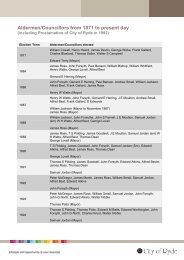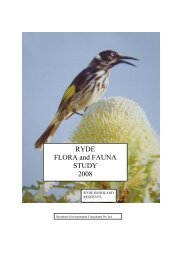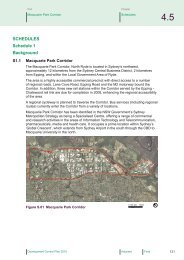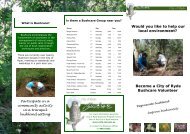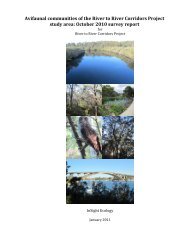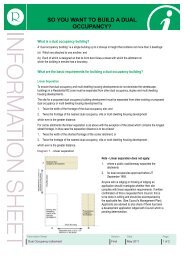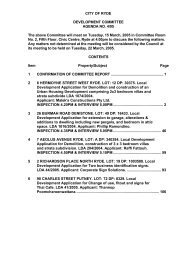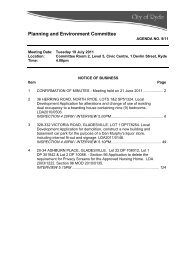RYDE FLORA and FAUNA STUDY 2007 - City of Ryde - NSW ...
RYDE FLORA and FAUNA STUDY 2007 - City of Ryde - NSW ...
RYDE FLORA and FAUNA STUDY 2007 - City of Ryde - NSW ...
You also want an ePaper? Increase the reach of your titles
YUMPU automatically turns print PDFs into web optimized ePapers that Google loves.
Biosphere Environmental Consultants Pty Ltd<br />
<strong>Ryde</strong> Flora <strong>and</strong> Fauna Survey <strong>2007</strong> 60<br />
general, however, replanting should be considered only when native plants cannot<br />
naturally re-establish themselves. Replanting is most <strong>of</strong>ten used:<br />
i) to quickly cover an area that is bare or has been cleared<br />
ii) to create a buffer zone around bushl<strong>and</strong> areas<br />
iii) to create habitats that have been lost from an area<br />
iv) to replace non-breeding or diseased endemic plants (through seed<br />
collection <strong>and</strong> propagation)<br />
The use <strong>of</strong> controlled planting to create buffer zones will be discussed below (in 6.6)<br />
while their use in creating habitats will be discussed in 6.7.<br />
6.6 Buffer Planting to Combat Edge Effects<br />
One <strong>of</strong> the problems that all bushl<strong>and</strong> reserves suffer from is “edge effect”. This term<br />
describes a variety <strong>of</strong> impacts that are experienced by bushl<strong>and</strong> that is in contact with<br />
non-bushl<strong>and</strong> areas. In <strong>Ryde</strong>, this usually means contact with residential areas, streets<br />
<strong>and</strong> recreational parkl<strong>and</strong>. The bushl<strong>and</strong> areas that follow creek catchments are more<br />
susceptible to edge effect because <strong>of</strong> their narrowness.<br />
The plants along the boundary <strong>of</strong> reserves are subject to much more physical damage<br />
<strong>and</strong> changes than the plants deeper in the reserve. Damage is caused by greater<br />
exposure to strong winds, sun <strong>and</strong> rain, <strong>and</strong> by regular contact with walkers who<br />
accidentally knock leaves <strong>and</strong> small branches or deliberately break <strong>of</strong>f projecting<br />
shoots or stems. In addition, the fringes <strong>of</strong> reserves are constantly bombarded with<br />
exotic seeds (borne by wind or storm water) <strong>and</strong> are further assaulted by mowing <strong>and</strong><br />
slashing <strong>of</strong> regrowth. Garden wastes <strong>and</strong> rubbish is also deposited along the edges <strong>of</strong><br />
the reserves. The combined effects <strong>of</strong> these pressures are to eliminate the more<br />
sensitive native plants <strong>and</strong> create gaps in the vegetation (that are later exploited by<br />
fast-growing weeds).<br />
Disturbance to the plants along the edges <strong>of</strong> reserves is a problem that will not end.<br />
Ideally, bushl<strong>and</strong> reserves need to be shielded from these impacts by a wall <strong>of</strong> more<br />
resilient, native plants that can tolerate greater physical damage <strong>and</strong> exposure. Such<br />
plants can create a buffer between the natural bushl<strong>and</strong> <strong>and</strong> the urban interface. Buffer<br />
plants must be hardy, native, non-invasive <strong>and</strong> easy to maintain. In short, they must<br />
not have the potential to become a pest in themselves.<br />
Many <strong>of</strong> the bushl<strong>and</strong> reserves in <strong>Ryde</strong> contain woodl<strong>and</strong> with an open understorey.<br />
The wide spacing <strong>of</strong> the ground plants makes it easy for weeds to become established<br />
<strong>and</strong> to eventually become the dominant ground cover. A buffer comprising tall, dense<br />
shrubs <strong>and</strong> other understorey plants that are locally endemic to the area would greatly<br />
reduce the seed load entering the reserves <strong>and</strong> block <strong>of</strong>f areas containing sensitive<br />
plants.<br />
6.7 Creating Habitats<br />
Open <strong>and</strong> semi-closed woodl<strong>and</strong>s were a feature <strong>of</strong> the <strong>Ryde</strong> l<strong>and</strong>scape (Howell <strong>and</strong><br />
Benson, 2000). While these woodl<strong>and</strong>s were widespread in the area in pre-European




